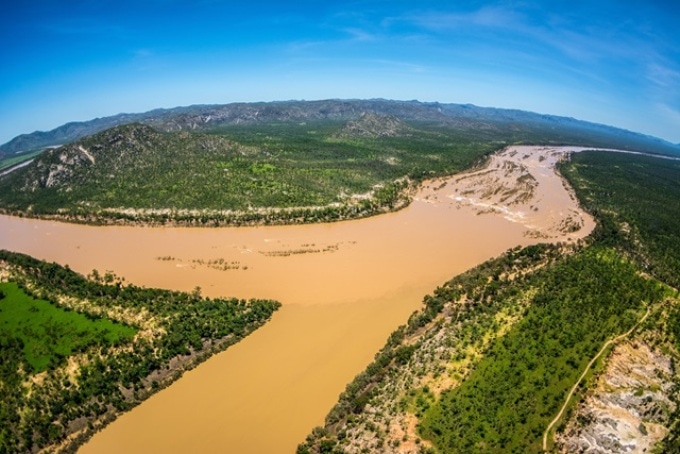Jul 18 2019
Leading Australian and international gully erosion experts will meet in Townsville next week and view first-hand the severe impact this type of land degradation is having on the Great Barrier Reef.
 Heavy rain around North Queensland in February 2019 caused many gullies to erode, removing soil from grazing land and elevating sediment loads in the Burdekin and Bowen Rivers, where they come together is shown in this photo. ©CSIRO, Matt Curnock
Heavy rain around North Queensland in February 2019 caused many gullies to erode, removing soil from grazing land and elevating sediment loads in the Burdekin and Bowen Rivers, where they come together is shown in this photo. ©CSIRO, Matt Curnock
The 8th International Symposium on Gully Erosion (8th ISGE) will take place from 22-27 July and feature 127 attendees including guests from China, India, Europe, the United States and Africa.
Gully and steam bank erosion is recognised globally as a significant source of sediment that is delivered to rivers and a natural hazard that can be accelerated by climate change, extreme events, and human land-use.
A key focus of protection and recovery efforts on the Great Barrier Reef are based in the catchments adjoining its coastline. Elevated sediment loads are damaging inshore coral reefs and seagrass beds within this important World Heritage Area.
Controlling gully and stream bank erosion is the main approach being used by land managers to reduce fine sediment.
“The highly variable climate and high intensity rainfall that occurs in tropical North Queensland has a strong impact on erosion,” CSIRO Great Barrier Reef coordinator Christian Roth said.
"Much of our erosion control work takes place in the huge Burdekin catchment, which is the same size as England and drains into the Great Barrier Reef lagoon south of Townsville.
“This is the first time the symposium has been held in the Southern Hemisphere, which is a big opportunity to connect people working in the reef catchments with expertise from around the world.
"It is also a great way to showcase the work being done right here to better understand and control gully erosion, because some of it is quite frankly at the cutting edge.”
Technical advice provided by CSIRO, Griffith University and other partners to control gully erosion is occurring in collaboration with landholders on more than 100 properties across the catchments that drain to the Great Barrier Reef.
Research has identified that gullies, or washaways as they are often known, are really vulnerable to erosion. Researchers are working with natural resource managers such as NQ Dry Tropics and Fitzroy Basin Association, and the grazing industry to develop practical and effective land management solutions for the Reef, and to help keep soil and nutrients on-property where they can be productive.
“Gullies are long term erosion issues which can be too big for landholders to solve on their own, but through the funding programs landholders are demonstrating long-term commitment to restoring gullied areas back to health,” Chair of the symposium organising committee and CSIRO Principal Research Scientist Dr Scott Wilkinson said.
“We still have a lot of work to do to improve water quality in the Great Barrier Reef, and there is a lot about gully erosion control that we are still learning.
"For example, new strategies for revegetating really degraded areas are being developed and tested, and small drones and laser scanners are revolutionising the way we measure and monitor erosion.
“Sharing results of scientific studies in this symposium, and bringing together different disciplines to learn from each other, is how we can improve management of gully erosion across the world.”
The symposium, which will be held at Rydges Southbank Townsville, is held every three years by the scientific community, to advance knowledge of how gully erosion works and ways to effectively manage and prevent it.
This year’s special guests include Queensland Chief Scientist Professor Paul Bertsch, and Dr Frederieke Kroon from the Australian Institute of Marine Science. International keynote speakers include Dr Robert Wells from the US Department of Agriculture.
In this Parliamentary sitting week, Special Envoy for the Great Barrier Reef Hon Warren Entsch MP will address the symposium via video message.
The significance of gully erosion to the GBR has been established through investment in catchment research programs such as the National Environmental Science Program (NESP) Tropical Water Quality Hub.
Researchers have recently collaborated to develop a second edition of the Gully and Stream Bank Toolbox, supporting erosion control projects in Great Barrier Reef catchments.
The Queensland Government, and the Australian Government’s Reef Trust are investing more than $60M of investment in gully erosion control.
More investment will follow through the Reef Trust Partnership program being implemented by the Great Barrier Reef Foundation.
The Townsville Symposium has been organised by CSIRO, University of Melbourne, Griffith University and NQ Dry Tropics.